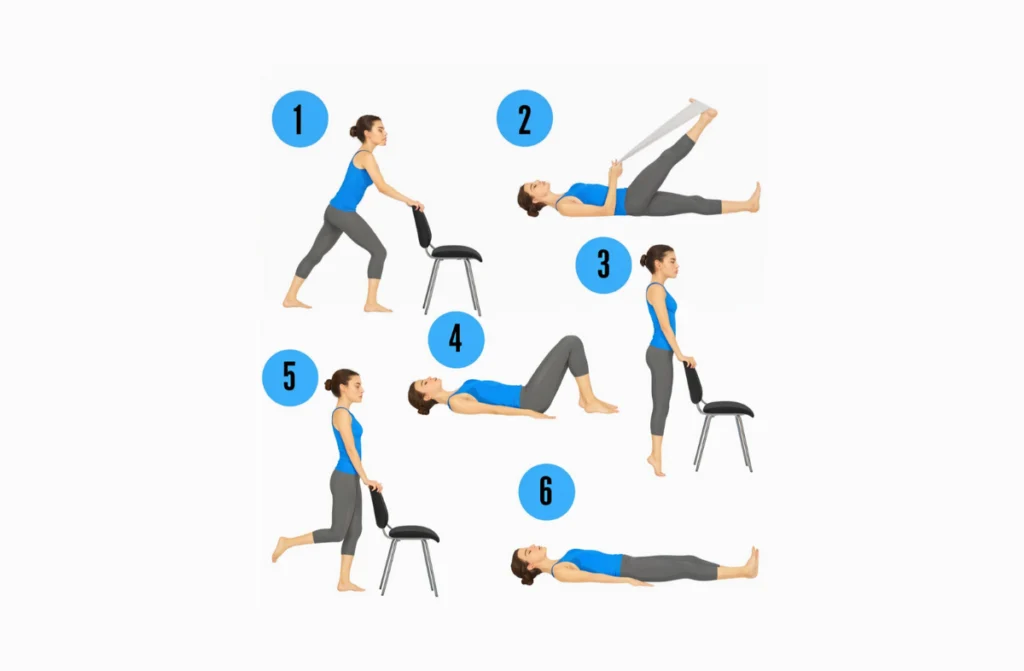Knee pain can affect your everyday activities, making it hard to walk, climb stairs, or even sit comfortably. One of the best ways to manage this discomfort is by engaging in specific exercises to reduce knee pain. By strengthening the muscles around your knees, improving flexibility, and promoting better joint health, you can effectively reduce pain and improve your quality of life. Let’s explore the causes of knee pain and the best exercises to tackle it.
Why is Exercise Important?
Exercise plays a significant role in managing bone-on-bone knee conditions by strengthening muscles, improving mobility, and reducing stiffness. Benefits include:
- Improved joint support: Strengthened muscles alleviate pressure on the knees.
- Better flexibility: Regular stretching increases joint range of motion.
- Pain relief: Endorphins released during activity can reduce discomfort.
- Enhanced overall health: Exercise promotes cardiovascular and bone health.
Incorporating the best exercise for bone on bone knees and engaging in physical therapy for bone on bone knees can significantly enhance your quality of life. Always work with a professional to design a safe and effective routine.

Exercises to Reduce Knee Pain
Knee pain can result from arthritis, injuries, or age-related degeneration, but gentle, structured movement helps restore flexibility and strength. The following Exercises to Reduce Knee Pain are designed to improve stability, reduce stiffness, and enhance mobility. While some movements focus on stretching tight muscles, others build supportive strength to ease the load on the joint.
Double Knee to Chest
The Double Knee to Chest is one of the simplest yet effective Exercises to Reduce Knee Pain. By gently pulling both knees toward your chest, you stretch the lower back, hips, and glutes, which indirectly helps release pressure from the knees. This stretch also improves blood circulation and relieves stiffness after long periods of sitting. For those practicing exercises for rheumatoid arthritis in knees, this move can reduce secondary discomfort caused by poor posture. Always hold for 20–30 seconds and avoid bouncing, as this is listed under knee arthritis exercises to avoid when performed aggressively.
Leg Cycle Exercise
The Leg Cycle Exercise mimics the motion of pedaling while lying down, making it a low-impact exercise for knee pain in old age. This rhythmic movement enhances flexibility, lubricates joints, and strengthens supporting muscles without direct joint compression. It is especially valuable in Exercises for Knee Osteoarthritis and Joint Pain, as it allows patients to regain mobility without overloading the joint. Aim for slow, controlled movements, ensuring that your range does not exceed comfort. Among knee exercises to reduce pain, cycling motions are widely recommended due to their smooth, non-jarring effect.
Leg Adduction
Leg Adduction strengthens the inner thigh muscles, which play a crucial role in stabilizing the knee. This exercise to reduce knee joint pain is typically performed by squeezing a soft ball or pillow between the knees, promoting balanced muscular support. Weak adductors often contribute to knee misalignment, worsening arthritis symptoms. For people seeking exercises for rheumatoid arthritis in knees, this movement supports proper tracking of the kneecap. Ensure controlled movements and avoid sudden jerks, as these can fall under knee arthritis exercises to avoid if done incorrectly.
Unweighted Flexion
Unweighted Flexion involves bending the knee through its natural range of motion without adding external resistance. This movement is one of the most practical Exercises to Reduce Knee Pain since it gently restores joint mobility. Patients with osteoarthritis benefit by regaining flexibility while preventing stiffness from prolonged inactivity. It is especially useful as an exercise for knee pain in old age, since it allows safe practice without strain. Start with 10–12 repetitions per leg, keeping the pace slow to avoid unnecessary discomfort.
Knee Full Extension Exercise
The Knee Full Extension Exercise focuses on straightening the leg completely while tightening the quadriceps. It is critical because loss of full extension often increases walking difficulties and pain. This is a highly recommended exercise to reduce knee joint pain for people recovering from surgery or dealing with arthritis. When performing Exercises for Knee Osteoarthritis and Joint Pain, ensuring full extension helps prevent compensatory hip or back strain. Deep squats or loaded lunges remain knee arthritis exercises to avoid until sufficient strength and control return.
Ankle Stretch
Though seemingly unrelated, the Ankle Stretch is one of the supportive knee exercises to reduce pain, as ankle mobility directly influences knee mechanics. Tight ankles often force the knees to compensate, leading to added discomfort. This stretch also benefits balance and walking stability, which is crucial for exercise for knee pain in old age. Gentle dorsiflexion and plantarflexion stretches maintain fluid movement in the entire lower limb chain. Many therapists include this in Exercises to Reduce Knee Pain programs to improve alignment.
Single Hamstring Stretch
The Single Hamstring Stretch targets the muscles behind the thigh that often contribute to stiffness around the knee joint. This is a classic exercise to reduce knee joint pain, as flexible hamstrings reduce unnecessary pulling on the knee. Hold each stretch for 20–30 seconds, ensuring you hinge from the hips rather than rounding the back. This is particularly helpful in Exercises for Knee Osteoarthritis and Joint Pain, since tight hamstrings exacerbate discomfort during daily activities. For safety, avoid bouncing, as ballistic stretching is among knee arthritis exercises to avoid.
Knee Stretch
Gentle Knee Stretching helps restore mobility in stiff joints, especially after periods of inactivity. This exercise for knee pain in old age is performed using a towel or strap to assist in bending or straightening the leg. It encourages blood flow and prevents joint locking, which is common in arthritis patients. As part of Exercises to Reduce Knee Pain, it allows controlled movement that builds tolerance. Overstretching, however, should be avoided, as it may aggravate inflamed tissues in rheumatoid conditions.
Straight-Leg Lift Exercise
The Straight-Leg Lift is among the most effective strengthening knee exercises to reduce pain, especially for those with weak quadriceps. By lifting the straightened leg without bending the knee, pressure is minimized while muscles are activated. This move is essential in both Exercises for Knee Osteoarthritis and Joint Pain and exercises for rheumatoid arthritis in knees. It is also safe as an exercise for knee pain in old age, helping maintain independence in walking. Avoid adding ankle weights too soon, as overloading is one of the knee arthritis exercises to avoid during early rehabilitation.
Straight-Leg Piriformis Stretch
This stretch targets the piriformis muscle near the hip, which can cause rotational stress on the knee if tight. Including it in Exercises to Reduce Knee Pain routines helps reduce strain across the hip–knee chain. Hold the stretch for 20–30 seconds, breathing deeply to relax tight tissues. It’s particularly valuable for patients looking for exercise to reduce knee joint pain caused by secondary hip imbalances. For individuals with rheumatoid arthritis, this gentle stretch is safer compared to twisting motions that fall under knee arthritis exercises to avoid.
Horizontal Straight-Leg Raise with Chair
This exercise involves raising the top leg while lying on the side, keeping it horizontal against a chair’s height. It builds hip abductor strength, which plays a huge role in knee alignment and stability. Strong abductors prevent knees from collapsing inward, which is critical in Exercises for Knee Osteoarthritis and Joint Pain. As an exercise for knee pain in old age, it improves walking balance and reduces fall risk. Performed correctly, it becomes one of the safest Exercises to Reduce Knee Pain while avoiding strain-inducing motions.
Want More Physiotherapy Exercises for Knee Pain?
- Quadriceps Strengthening. Tighten the thigh muscles while keeping the leg straight, holding for a few seconds before relaxing. Strong quads are essential in Exercises to Reduce Knee Pain and help improve walking stability.
- Straight-Leg Raises. Lift the straightened leg slowly from the floor while lying down, focusing on control. This exercise to reduce knee joint pain strengthens quads without stressing the knee.
- Mini-Squats. Perform shallow squats while holding support, keeping knees aligned with toes. These are safe knee exercises to reduce pain and support daily mobility.
- Stationary Cycling. Use a cycle at low resistance for 10–15 minutes. This is ideal for Exercises for Knee Osteoarthritis and Joint Pain, improving circulation and flexibility.
- Hip Abduction. Lift the leg sideways while lying on your side or use a resistance band. Strong hips reduce pressure on the knees and prevent inward collapse.
- Hamstring Curls. Bend your knee slowly while standing or lying down. This balances strength across the joint, supporting exercise for knee pain in old age.
- Aquatic Therapy. Water-based walking or leg drills reduce joint stress and pain. Perfect for early rehabilitation and exercises for rheumatoid arthritis in knees.
Additional Tips for Reducing Knee Pain
- Focus on balance. Simple drills like single-leg stands improve stability and reduce falls, especially for seniors managing knee pain.
- Choose low-impact activity. Swimming, walking, and cycling reduce stress on joints compared to running or jumping, making them good Exercises to Reduce Knee Pain.
- Watch body weight. Even small weight loss reduces joint pressure significantly, enhancing the effect of exercise to reduce knee joint pain.
- Use heat and cold. Warmth before activity reduces stiffness, while ice after exercise helps swelling. Both support recovery in Exercises for Knee Osteoarthritis and Joint Pain.
- Avoid risky movements. Deep squats, heavy lunges, or high-impact jumps are knee arthritis exercises to avoid. Safer alternatives protect joints.
- Wear supportive footwear. Proper shoes and orthotics distribute weight evenly, useful for exercise for knee pain in old age. use emoji
Conclusion
Regular Exercises to Reduce Knee Pain can make a significant difference in your overall joint health. Whether you’re dealing with osteoarthritis or injury-related discomfort, these exercises can help you feel better and move more easily. If you need more information or guidance on managing your knee pain, don’t hesitate to reach out to a physical therapy for bone on bone knee or healthcare provider. Contact us today to learn more about how we can help you stay active and pain-free.
